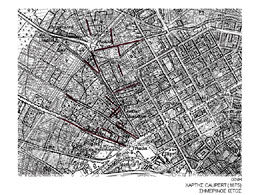STUDENTS PROJECTS
2010

28 March, 2011
Interventions of reformation in the area of Metaxourghio.
Investigation of spatial, functional and social impact of their implementation.
Students: Angelina Apostolou, Constantinos Stamoulidis
Supervisors: Cornelia Zarkia, Kimon Thermos
University of Thessaly, School of Engineering, Department of Architecture
Presentation date: 04 March 2010
Short description
Taking into account the character of Metaxourghio and the general mood for its upgrade, the thesis investigates ways of intervention, having as a goal the coexistence of elements of the diversity (temporal, spatial, functional, cultural). At the same time, it investigates the consequences of its implement in the character of the region as well in Athens in general, to the point that this particular region consists part of the historical centre.

Presentation
Basic element of the initial problem was to find a way to manage the vivid and active part of the athenian metropolis which has such an intense character and controversial elements. Today Metaxourghio is a region of the centre of Athens that goes under many changes whilst at the same time condenses so many controversial traits and goes through sensitive balances. These date function as an evolving platform of a wider sceptical thinking for the management of such regions.
The thesis explores ways of intervention in the area of Metaxourgio in Athens with the aim of coexistence of the elements of diversity (temporal, spatial, functional, cultural). At the same time, it explores the consequences of their implementation in the character of the region, but also in Athens generally, to the extend that the area constitutes part of the historical centre. The current character of the area and the general availability of the state to upgrade it as residence region near the historic centre are taken into consideration as data. The main tool of the study is the emergence of archaeological sites (Dimosion Sima, Iera Odos) and evidence of the recent history of the region (neighborhood of 19th - 20th centuries, factory of Metaxourghio [silk factory]).
In the analysis and recognition of the status quo in the region are taken into account a variety of parameters in order to reach more globally its intense character. The location of the area in the agglomeration of Athens is observed carefully. Also, the degree of correlation with the wider region of the capital is examined and critical scope positions of city level as well (archaeological site of Kerameikos, Technopolis - Gazi, Omonia Square, Psirri - Plaka - Monastiraki, Votanikos). The historical dimension of the region is recorded, from ancient times until today and the way of its integration in the plans of the capital of the new Greek state and its evolution during the 19th and 20th century. The social and anthropological dimension of the region are approached as well, as it stands today and the different groups that make it up within the context of migration, abandonment and obsolescence of the centre on the one hand and the simultaneous settlement of the medium or large income groups on the other hand. Finally, issues of urban fabric and block are approached, as well as their production process in time and space. In this context, the natural, historical, archaeological and urban trails are explored. These traces constitute alignments, whether tangible or intangible waste-products of the past the latent presence of which is inherent in the present contributing to the current produced space and character of the region.
To the designing proposal lead the conclusions of the analysis. Ways of management of urban fabric are explored in order to determine the space produced through the potentially built (block, free building) or unbuilt (street, square) elements of space. There is an attempt of the control of the conflicting relationships developed in components in such a way that the differentiation of one element changes the balance of the system. General and specific alignments of urban fabric and links of points of special interest are determined. As critical positions in the region are defined two zones transverse in Piraeus Avenue: Giatrakou Square & the Metaxourghio Building and the zone which is identified with Dimosion Sima of the ancient city. However, equally critical is the area located between the two as a transition area.
The questioning included in the proposal concerns the coexistence in space and time of data created at a different time, in different social and cultural contexts since the region constitutes a palimpsest. The objective is the modern reading of urban space through these points of difference.















